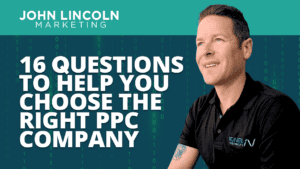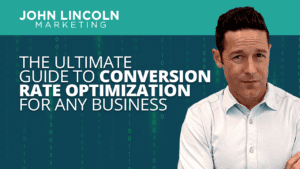
Top 16 Questions to Ask a PPC Company in 2024
In 2024, choosing the right PPC company is not just about spending your advertising budget. You want to make every cent count towards your business

If you’ve been doing this digital marketing thing for a long time, you’ve undoubtedly heard of Google Analytics. It’s a tool used to gather information about visits (and visitors) to your website.
In this GA4 training session, I’ll explain why you should adopt this newer version. I’ll also cover some GA4 features so you’ll know how to use it.
First up: let me answer the question about why you should move to GA4.
Sadly, you don’t have a choice. Universal Analytics (GA3) is getting scrapped in July of this year (2023).
So if you haven’t yet made the switch, I suggest doing that… yesterday.
Second, GA4 works for both websites and mobile apps. That’s exceptional if you’re developing both kinds of applications.
Next, the roll-up reporting in GA4 is far more accurate than what you got in the previous version. That kind of detail can help you make smarter decisions about your online marketing.
Most importantly, GA4 gives you more user privacy control options. Since everybody is privacy focused these days, you’ll find that useful.
Nowadays, we live in a whole new world of measurement.
For starters, you’ve got to deal with that privacy thing I just mentioned. Enhanced privacy makes measurement a bit more challenging.
Why? Because you’re gathering limited info about each visitor. That makes it more challenging to engage in precise targeting.
Also: expect cookies to disappear.
If you’re unfamiliar with cookies, they’re little pieces of digital info that websites store in your browser. You’ve probably noticed that you need to consent to cookies on many websites you visit.
Well, you may have consented. But that doesn’t mean that everybody else does.
And the people who don’t? Yeah, you can’t gather info about them from cookies.
Further, keep in mind that regulations regarding privacy exist in some jurisdictions. Consider Virginia, California, and the European Union (EU) as examples.
Next, I’ll cover the concept of first-party data.
What’s first-party data? It’s data you’ve collected yourself, on people who’ve visited your site.
It stands apart from third-party data like user info gleaned on some of the advertising platforms you might like.
Mostly, you’ll collect first-party data from your customer relationship management (CRM) software. Salesforce is widely considered the “Rolls Royce” of CRMs, but plenty of other options exist.
One of the most significant advantages of first-party data is that it gives you a holistic view of the contact or customer. That enables you to fine-tune your marketing to individual needs.
But what does that have to do with GA4?
GA4 offers server-side tracking. That means you can use Google’s analytics server to collect data without relying on cookies.
So instead of sending the data directly to GA4, you send the data to the analytics server. And that server can send the data to third parties.
Further, that server-side tracking follows users across devices, even when they’re not logged into Google.
As a result, you’ll get a more accurate understanding of the user’s interests.
Another reason to make the shift to GA4: shifting user behavior.
Since introducing the soon-to-be-extinct Universal Analytics, we’ve seen the market change.
There are now more devices, channels, and touchpoints than before.
And UA wasn’t ready for that dynamic.
Your needs have changed as well.
You’re asking more questions than before, searching for more customization and automation. You’ve learned from experience.
Putting all that together makes a solid case for moving to GA4. It’s well-suited to tackle the challenge of modern-day digital marketing.
One more thing: GA4 is much better at handling cross-channel marketing than its earlier version. You can plug in several datasets and create reports that crunch numbers from each set.
Then, you can decide where you want to go next.
Here’s another reason to get excited about GA4: machine learning.
For example, the tool gives you predictive audiences.
Using key criteria, the tool will create a list of audiences who will probably churn over the next month.
It will also give you an audience that will probably convert during that same timeframe.
And once you’ve got your audiences in hand, you can create a state-of-the-art marketing funnel that enables you to target your users.
It gets better. Once they respond, you can segment those users further based on event data. Then you can remarket to those folks.
Here are some specific actions you can take with predictive audiences:
Come up with strategies specific to your business model.
Start using innovative marketing strategies with predictive audiences and you’ll reap two benefits: more revenue and reduced conversion costs.
Remember, with machine learning, the audiences will become more accurate with more data. So, you will need hundreds of users and purchases to get a precise read.
GA4 also lets you get answers to your questions quickly.
How does it do that? By giving you a search bar that enables you to ask it a question.
Yes, you can ask the tool a question in plain English. And it will answer.
Ask questions like:
And so on.
No more fishing around for the correct menu item to find the data you’re looking for.
Are you still looking for a reason to drool over GA4? Look at the unified user journey.
With the old tool, you couldn’t create funnel steps unless they were page-load events.
But with GA4, you can create funnels based on any event: a page load, a session, a conversion, etc.
Those analytics will give you a better picture of the overall customer journey. They’ll also help you answer the very important question: how much does it cost to acquire one customer?
GA4 is also future-proof.
What do I mean by that?
GA3 collected data in ways that are now against the law in some jurisdictions.
And since it doesn’t have the correct privacy requirements in place, that’s yet another reason to appreciate GA4.
Specifically, GA4 enables you to work with consent requirements. You can adapt data collection to user and legal requirements.
Yes, GA4 lets you customize privacy controls based on country. It’s difficult to overstate the importance of that feature.
Simply put: you won’t store data from users who don’t want it stored. The whole concept gets a little more involved than that, but that’s a subject for another article.
GA4 enables you to use first-party data to fill gaps from cookie loss. Then, you can use that data for targeting purposes.
Yes, GA4 integrates with YouTube.
YouTube is a Google property, after all.
You can link your website to Google Ads. And then, when you run ads on YouTube, you can collect conversion events from people who watch at least 10 seconds of one of your skippable ads.
And if a user converts on your site within 72 hours of viewing one of your YouTube ads, you can track that event as part of the customer journey.
You’ll also see Engaged View Conversions (ECVs) in your GA4 analytics reporting.
Don’t waste time. Make the switch to GA4 now.
Why? For starters, GA4 won’t start collecting data until you move.
So you’ll have limited data if you delay the inevitable. And, as we’ve seen, with limited data, you could get inaccurate predictive audiences and insights.
Also, your competitors might have GA4 already set up. That means they’ve got the data that you don’t have.
So bite the bullet.
I know change isn’t easy. But moving to GA4 is one of those things you can’t afford not to do.
Welcome to John Lincoln’s personal website. You can learn about John Lincoln’s books, films, book him to speak and contact him. John is directly associated with many of the businesses mentioned on this website and freely discloses this information.

John Lincoln is CEO of Ignite Visibility, one of the top digital marketing agencies in the nation. Ignite Visibility is a 6x Inc. 5,000 company. Ignite Visibility offers a unique digital marketing program tied directly to ROI with a focus on using SEO, social media, paid media, CRO, email and PR to achieve results. Outside of Ignite Visibility, Lincoln is a frequent speaker and author of the books Advolution, Digital Influencer and The Forecaster Method. Lincoln is consistently named one of the top digital marketers in the industry and was the recipient of the coveted Search Engine Land “Search Marketer of The Year” award. Lincoln has taught digital marketing and Web Analytics at the University of California San Diego since 2010, has been named as one of San Diego’s most admired CEO’s and a top business leader under 40. Lincoln has also made “SEO: The Movie” and “Social Media Marketing: The Movie.” His business mission is to help others through digital marketing.
Want to get in touch with John Lincoln? Click Here To Reach Out.

In 2024, choosing the right PPC company is not just about spending your advertising budget. You want to make every cent count towards your business

Whether you’re a seasoned marketer or just starting out, conversion rate optimization (CRO) is a powerful tool that can boost your sales, leads, and overall

Feeling overwhelmed by the sea of SEO companies out there? You’re not alone! Choosing the right partner is crucial for achieving your online marketing
 Why is Bounce Rate So Important? What Is It & How to Find It
Why is Bounce Rate So Important? What Is It & How to Find It Imagine this: somebody visits your website and then leaves right away.Is that what you want? Hopefully not.But when that happens,